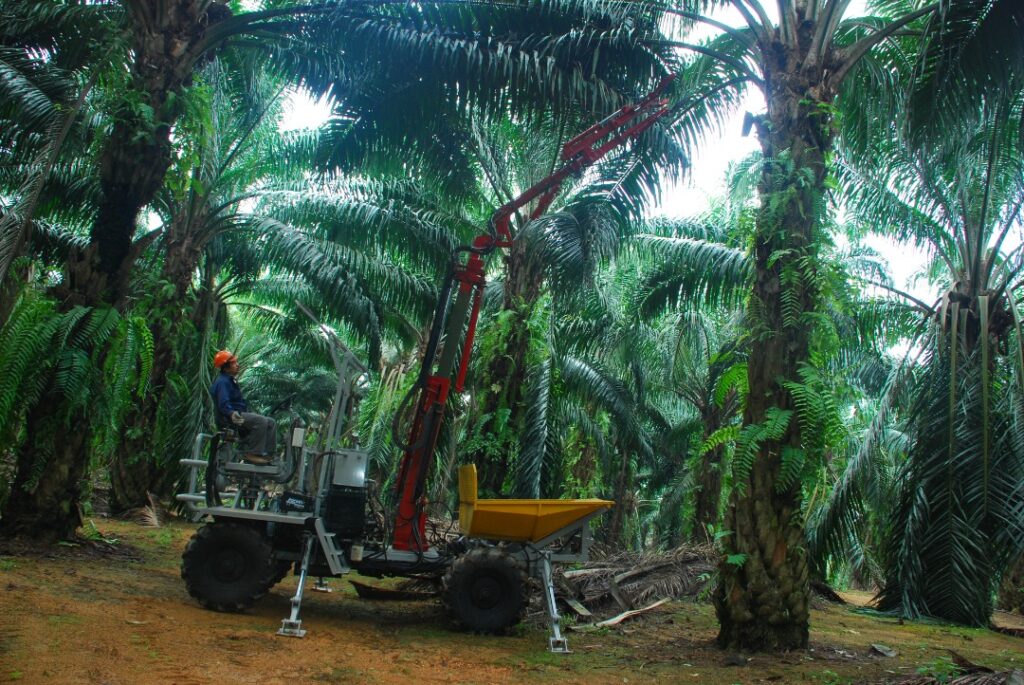
Pic courtesy of MPOB — a modern oil palm estate using mechanical harvesting
by Dr Rahim Said
KUALA LUMPUR, Sept 28: The world of edible oils has undergone a notable shift, with palm oil, traditionally the cheapest option, now commanding a rare premium. Once considered the king of affordability, palm oil has lost its price advantage over rivals like soybean, sunflower, and rapeseed oils.
For those tracking global markets, this is not merely a headline; it carries substantial implications for producers, consumers, and industries alike.
Palm oil, a staple commodity used in everything — from food products to cosmetics — has always benefitted from its year-round harvest cycle and low land-use requirement, making it a seemingly unbeatable choice for industries worldwide. However, a perfect storm of reduced output in Indonesia and Malaysia — that together account for 85 percent of the global supply — and better crop yields from alternative oils has disrupted this status quo.
The reluctance of smallholders in Southeast Asia to replant ageing palm trees, due to the long gestation period before new trees bear fruit, exacerbates the issue. While soybean can be harvested within six months, palm trees take four to five years to mature. This has led to a 10 percent rise in palm oil prices in 2024, while soybean oil prices have fallen by 9% due to improved crop conditions in regions like the US.
So, what does this mean for the palm oil market, which is so integral to global industries?
A Temporary Blip or Structural Shift?
Some argue that this price inversion is merely a short-term disruption, driven by seasonal factors. For instance, in India, the world’s largest palm oil importer, demand typically drops during the colder months when palm oil solidifies, leading consumers to temporarily shift to alternative oils. This trend is expected to lower demand come December and January, potentially restoring palm’s competitive edge.
Yet, this narrative may oversimplify the complexities at play. While palm oil may be experiencing a temporary spike, the underlying structural challenges –particularly the reluctance to replant old trees — suggest that palm oil could continue facing supply constraints for years.
Moreover, alternatives like soybean and sunflower oil, which are benefitting from better yields and shorter harvest cycles, are not just sitting idle. These crops have become increasingly competitive, offering industries a viable substitute, particularly in price-sensitive markets.
The Biodiesel Buffer and Industry Resilience
While some palm oil users, particularly households, might shift to cheaper alternatives, the overall demand for palm oil remains resilient. This is due in part to its unique qualities — its versatility, stable shelf life, and wide industrial application make it indispensable to sectors such as confectionery, fast food, and biofuels. In Indonesia, for example, rising demand for palm-based biodiesel continues to support prices.
Large buyers, including cookie makers and fast food chains in countries like India, are unlikely to fully switch to alternatives like sunflower oil, despite temporary price fluctuations. According to Bloomberg, Aashish Acharya of Patanjali Foods suggests, industrial buyers are deeply entrenched in palm oil due to its unique characteristics. This entrenched demand will likely serve as a price buffer in the near term.
Smallholders and Sustainability: The Long-Term Threat
However, the deeper problem lies with the producers themselves. The reluctance of smallholders to replace ageing palm trees has created a bottleneck in supply. This points to a larger issue: the structural inefficiencies in palm oil production and the dependence on aging infrastructure. This is compounded by the global push for sustainability, where the demand for eco-friendly practices could raise production costs, further undermining palm oil’s affordability.
The palm oil industry, historically criticised for deforestation and environmental degradation, is now also being squeezed by mounting pressure for more sustainable practices. To maintain market dominance, the industry may need to invest in both replanting efforts and more sustainable, yield-efficient practices. Failing to do so will not only jeopardise palm oil’s price competitiveness but could also push buyers toward more sustainable alternatives.
A Market Correction or an Existential Crisis?
As we look ahead, the question remains: Is the current rise in palm oil prices just a temporary market correction, or is it indicative of a larger existential crisis for the industry?
While seasonal demand fluctuations and supply-chain dynamics suggest that prices may stabilise in the coming months, the deeper, long-term structural challenges cannot be ignored.
Palm oil’s future as the dominant global edible oil may hinge on the industry’s ability to address these systemic problems — replanting aged trees, improving sustainability, and competing against increasingly efficient alternatives. If these challenges remain unaddressed, the days of palm oil reigning as the world’s cheapest oil may be permanently behind us.
In the end, the palm oil market, much like the commodity itself, is at a crossroads: either adapt or risk losing its crown to cheaper, more sustainable rivals.
The next few years will prove crucial in determining whether this is merely a bump in the road or the beginning of a long-term shift in the global edible oil landscape.
WE